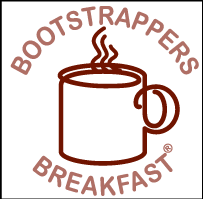The following is an edited transcript of the “Learning Hacks for Bootstrappers” briefing by Elena Krasnoperova at the Bootstrapper Breakfast on Fri-Dec-2-2016. She had a “cheat sheet” she handed out that is interleaved here in her remarks. We have added hyperlinks where they help to clarify or elaborate on her remarks.
Elena Krasnoperova on Learning Hacks for Bootstrappers
 I am going to talk about learning hacks, but I want to give you a little bit of context on why I think I’m qualified to give this talk. I came here from Russia 26 years ago. It was supposed to be a one-year exchange program. Apparently they don’t count very well. I just stayed behind and never went back. I’ve been on this entrepreneurial journey for the last three years. It’s been the hardest thing, orders of magnitude harder than I expected it to be.
I am going to talk about learning hacks, but I want to give you a little bit of context on why I think I’m qualified to give this talk. I came here from Russia 26 years ago. It was supposed to be a one-year exchange program. Apparently they don’t count very well. I just stayed behind and never went back. I’ve been on this entrepreneurial journey for the last three years. It’s been the hardest thing, orders of magnitude harder than I expected it to be.
When people ask me, “Should I go into entrepreneurship?”
I answer, “Please don’t, not if you can help it.”
Unfortunately for me, I couldn’t help it.
I began with an optimistic attitude and the desire to solve a problem that my family was having. We are proud parents of two wonderful kids, now 8 and 10, and our school communicates updates and announces meetings and events primarily by email.
We found that we were spending too much time going through the emails, copying and pasting things into our calendars (and still missed important events in our kids’ lives).
We felt overwhelmed with managing all of the announcements and updates, and felt like bad parents when we sometimes missed one of them. I knew there had to be a more efficient way, so I set out to solve that problem.
The original idea was to find a tech solution and replace the email announcements with something better. My husband and I designed a special calendar software and called it “Simply Circle”.
At this point I can write a book–about two inches thick–of what not to do: Things that I tried that could have, should have, plausibly worked, but didn’t. Someday I will write that book. You guys are welcome to contribute chapters to said book. I can write a very short companion book of what to do.
I decided to make a second attempt at solving the same problem, but approached it from a different angle and called it Calroo. The problem I am attempting to resolve remains the same: improve the communication and scheduling challenges that occur between parents and their children’s school activities. We are helping parents survive parenthood and maybe even enjoy it a little bit.
This time, it’s a consumer app. that goes directly to the moms and dads, to calendar their busy family schedules. It and helps them coordinate things amongst themselves so that you’re not inviting your husband to a school concert, and even when he accepts, you’re going, “Well, are we both going? Is he going so I don’t have to? Or am I going and I am just informing him?”
It provides clarity about who is doing what. It makes the hand-offs really, really easy. It integrates to-do’s, calendars, and messaging in one convenient app. I’m crossing my fingers so hard it hurts that this will do well.
I’m pouring everything that I learned from my take one, the problem, into the second attempt and hopefully correcting for these things. In the meanwhile, I just learned a ton. I’m here to impart my tips and hacks on how to learn new skills. I’m going to pass out a cheat sheet so you can take notes. I left margins deliberately. I’m a scribbler, so if you are as well, you can feel free to take notes as we go along.
Schedule and Protect Your Time for Learning New Skills
Step 1: Make time for learning new skills – your startup’s success depends on it
- Block time off on your calendar – e.g., Fridays 2-5 pm is learning time
- Sign up for live classes or seminars as a forcing function
- Leverage your “dead time”: waiting, commute, boredom, etc.
from Elena Krasnoperova’s “Seven Learning Hacks for Bootstrappers“
As bootstrappers we cannot compete with VC funded companies or public companies using money. We can’t hire people for every job that needs to be done. We can’t hire experts because the good ones are very expensive. We cannot afford to spend a lot of time to become an expert, so we have to get good at learning. The reality for bootstrappers is that learning new skills is a matter of business survival. We need to learn fast and to be really effective at applying these new skills.
You may have heard the parable of the two lumberjacks who are cutting wood with saws.
They’re both working hard. One of them is just trying to put in more hours and work harder.
The second lumberjack takes an hour off, disappears and returns.
The first lumberjack asks: “Where were you?”
The second lumberjack answers, “I was sharpening my saw.”
For us, learning new tools is the equivalent of sharpening the saw, because when our saws are sharp, we can cut those trees a heck of a lot faster.
One of the challenging things for a bootstrapper–especially if you are a solo entrepreneur or working in a very small team–is that you never feel like you have time to learn.
As a parent, I never have time. You have to literally make it. Whatever tricks and forcing functions you have to use to reserve that time and protect it for learning, do it.
One of my personal tricks is to block off my Friday afternoons for learning time. Frankly, by the end of the week, I am so exhausted I can’t think straight (but I can think enough to be able to at least absorb new things).
The other thing that I do is I use forcing functions, which is that I sign up for seminars, conferences, et cetera, because I know that has to be at a particular time in a particular space. Especially if I’ve paid an admission fee I will attend. I bring my trusty computer and if the talk is not so good, I will be multitasking, but at least I will be there. For me, it’s a forcing function, to create that space and time.
I also try to use those snippets of time when I’m waiting for something, in the doctor’s office, or on a long commute. It’s fine to listen to music but I often use the time to listen to a podcast or a book on tape instead.
Hack number one is to accept that you need to learn new skills. That this is literally a matter of survival and success for your startup. Therefore, you need to carve out and protect the time for learning.
Different Learning Styles
Step 2: Figure out your preferred learning style, as that will determine your learning medium. 3 questions to ask yourself:
- Verbal or visual? (Books & blog posts vs infographics, video & webinars)
- Reading or listening? (Books & blog posts vs. podcasts, videos & live lectures)
- Learn individually or in a group? (Read, listen or watch on your own vs. take a class / seminar)
from Elena Krasnoperova’s “Seven Learning Hacks for Bootstrappers“
I’m a psychologist by background. I’ve always been fascinated by how people think, how they learn, why the heck they do the things they do. I’m still working on that, trying to figure that out. But one of the things that I know both from my own experience as well as from watching my kids–one of them is autistic, my little guy–is that we all have very different learning styles. We absorb information in different ways. What I’m encouraging you to think about is if you haven’t thought about it exclusively, is how do you learn best?
Then seek out information that is compatible with your learning style: verbal or visual, reading or listening, individual or group.
Of course, it’s not all mutually exclusive, you can pick and choose, but in my case, I’m definitely a word person, so I like to read a lot. I read a book a day. And I’m a fast reader, needless to say. I cannot stand videos where there is five minutes of reading in a 20-minute session: the speed of download is too slow. I just want the Cliff Notes.
Three Recipe Books: Lean Startup, Traction, and Lean Analytics
Step 3: Master the basics – start by reading (or listening to) these 3 books:
- The Lean Startup by Eric Reis
- Traction by Gabriel Weinberg and Justin Mares
- Lean Analytics by Alistair Croll and Benjamin Yoskovitz
from Elena Krasnoperova’s “Seven Learning Hacks for Bootstrappers“
Here are my key recipe books for the three most important aspects of a startup: the product, sales and marketing, and the business. Lean Startup is about lean development, which means that you build products that people actually want. It’s super helpful about how to think about bringing the right product to market. And not just crossing your fingers so bad it hurts, hoping that the market will like what you are bringing. Traction is for sales, because traction trumps everything else. Lean Analytics for business models.
You have to think about these three aspects in parallel: you have to think about the market while you’re building the product and the business model must fit the product and the market. These are not sequential but iterative assessments you make in parallel.
How do you know what you don’t know?
Step 4: Figure out what skills you need to acquire next that will be most helpful to your startup. Three questions to ask yourself:
- What stage is your startup at?
- What are your business goals?
- Where are your most critical knowledge gaps, given the above 2 things?
from Elena Krasnoperova’s “Seven Learning Hacks for Bootstrappers“


If you’re a technical person, you may think that sales is a dirty word. Get over it. Because it’s especially if you are a solo entrepreneur or a bootstrapper, you can’t just be good at one thing. You have to launch and market your product, to make money from your product. Even if it’s uncomfortable.
Maybe you are a sales person who can sell ice to Eskimos but you are not comfortable with numbers or building a business model. Get comfortable with numbers to complement your sales skills. The numbers will keep you honest.
Acquire, Absorb, and Apply the Know-How You Need
Step 5: A1 – Acquire the knowledge (in your preferred learning style)
- If you like to read:
- Start by Googling what you want to learn: e.g., “best copywriting blogs”.
- Look at the top results, read/list/watch them, then see whom they reference, and read that
- On Amazon: search books by topic -> sort by popularity / reviews -> skim reviews -> download free Kindle sample -> buy Kindle book -> buy paper book for reference
- If you like to watch videos, search on YouTube, or add “video” or “webinar” to your Google search
- Try adding “checklist”, “cheat sheet” or “template” to your Google search
from Elena Krasnoperova’s “Seven Learning Hacks for Bootstrappers“
I start with Google and start reading to get some context. And then I will search on Amazon for some of the popular books, read some reviews and a sample chapter and then pick a few to read. I often read a book a day. I take notes as I read to help me remember, or I will use the Kindle highlight to help me focus on a key point.
Collect Examples of What Works
Step 6. A2 – Absorb the knowledge
- Take notes – handwritten / typed, screenshots, email summaries, highlighting on Kindle, Evernote, etc.
- Create a reference library in whatever format is most useful for you – physical (books, binders with printouts, handwritten notebooks), or digital (PDFs, Evernote, emails, bookmark web pages, etc.)
- Create a swipe file with the best real-life examples of a given topic (e.g., emails that prompted you to open them or click on them, direct mail pieces that caught your attention, etc.)
from Elena Krasnoperova’s “Seven Learning Hacks for Bootstrappers“
The last and probably the best tip I have is to create a swipe file. A swipe file is your library of stuff that works.
So, let’s say you want to learn about direct marketing you can start saving direct mail that you get at your house.
For example, if you are learning about email marketing, subscribe to every email list on the planet. Then see which kinds of headlines catch your attention. Which subject lines work for you. Which call to actions work for you. When you visit the websites and you’re trying to optimize the conversion of your website from visitor to sign up, notice what is capturing your own attention.
I admit that this is a little biased because you’re answering “what works for me.” But it’s a place to start clipping and collecting. Clip the things that you like, that work for you in whatever area you’re interested in. Create a massive swipe file.
Learn by Doing–Start Small
Step 7. A3 – Apply the knowledge – “Just do it!”
- Do “homework” or “action plans” that many materials designed for entrepreneurs include
- MOST IMPORTANT: Do a real project to solve a real problem for your startup
- Reference the best cheat sheets, templates or checklists that you found for that topic
- Consult your swipe file and your reference library
- If needed, dig in deeper into the area and learn more in-depth content / skills
from Elena Krasnoperova’s “Seven Learning Hacks for Bootstrappers“
Most importantly, “do a real project to solve a real problem for your real stuff”. That’s why you were learning it in the first place. It was not academic. You’re trying to solve a problem. In my case I’m trying to launch an app and get noticed where there are already more than 2,000 others in my category. So I wrote an email and read it and said to myself, “Oh crap, I still don’t know how to do this.” So I revised it and kept repeating the cycle.
SKMurphy Take on Briefing by Elena Krasnoperova


Related Blog Posts
- Labor Day 2014: Knowledge Work Productivity
- Hard Drive: Seven Practices I Used to Launch a Successful Startup
- Founder Story: Edith Harbaugh of LaunchDarkly
- Matt Wensing On Making the Transition to Growth
- Matt Oscamou of Frontier Bites on the value of the Bootstrapper Breakfast
- Dan Shipper: Every Sustainable Business Follows From Solid Fundamentals
- Ryan Waggoner: Maybe Startups Are So Hard Because We’re Doing Them Wrong
- Paul Lippe on an Entrepreneur’s Accountability
Photo Credit: “It’s More Complicated Than That is from Edward Tufte‘s series of “Philosophical Diamond Signs” that use the format of diamond signs that provide alerts and warnings about the road ahead, this series of works on canvas shows philosophical alerts, imperatives, and thoughts about the path past and future.

Pingback: SKMurphy, Inc. Quotes For Entrepreneurs-September 2013 - SKMurphy, Inc.
Thanks for sharing this article, as a Russian immigrant in Canada I can relate to Elena’s story.
Pingback: Silicon Valley Roundup for Feb-Mar-2017 - BootstrappersBreakfast